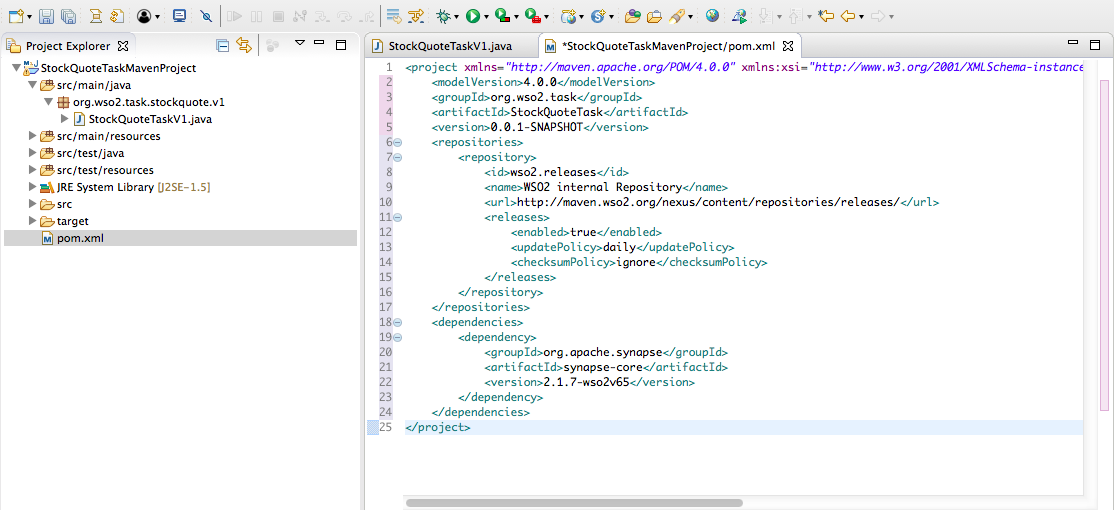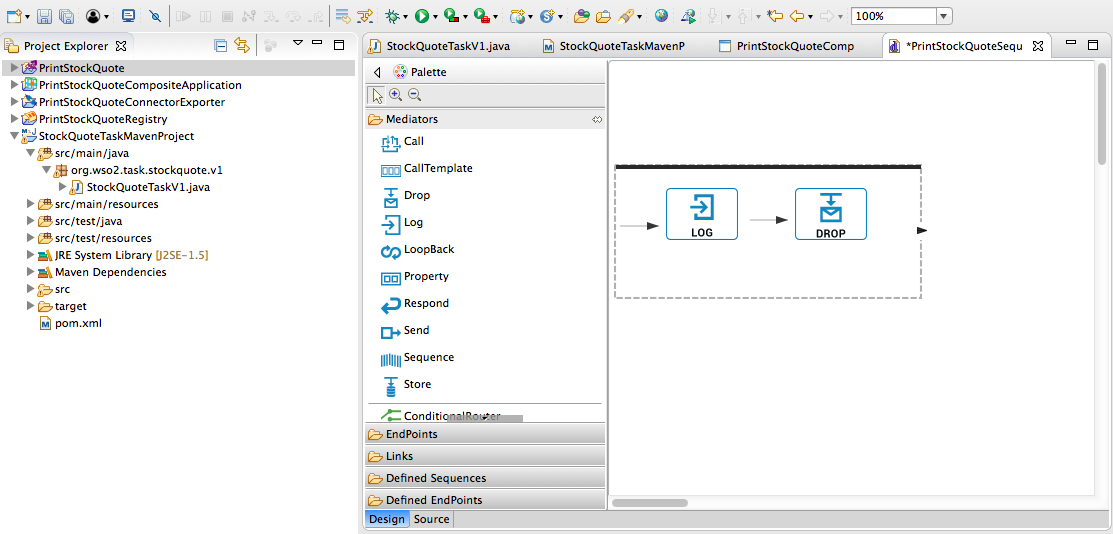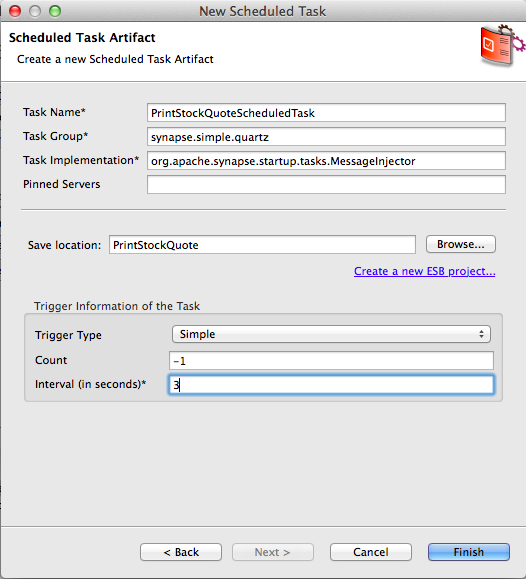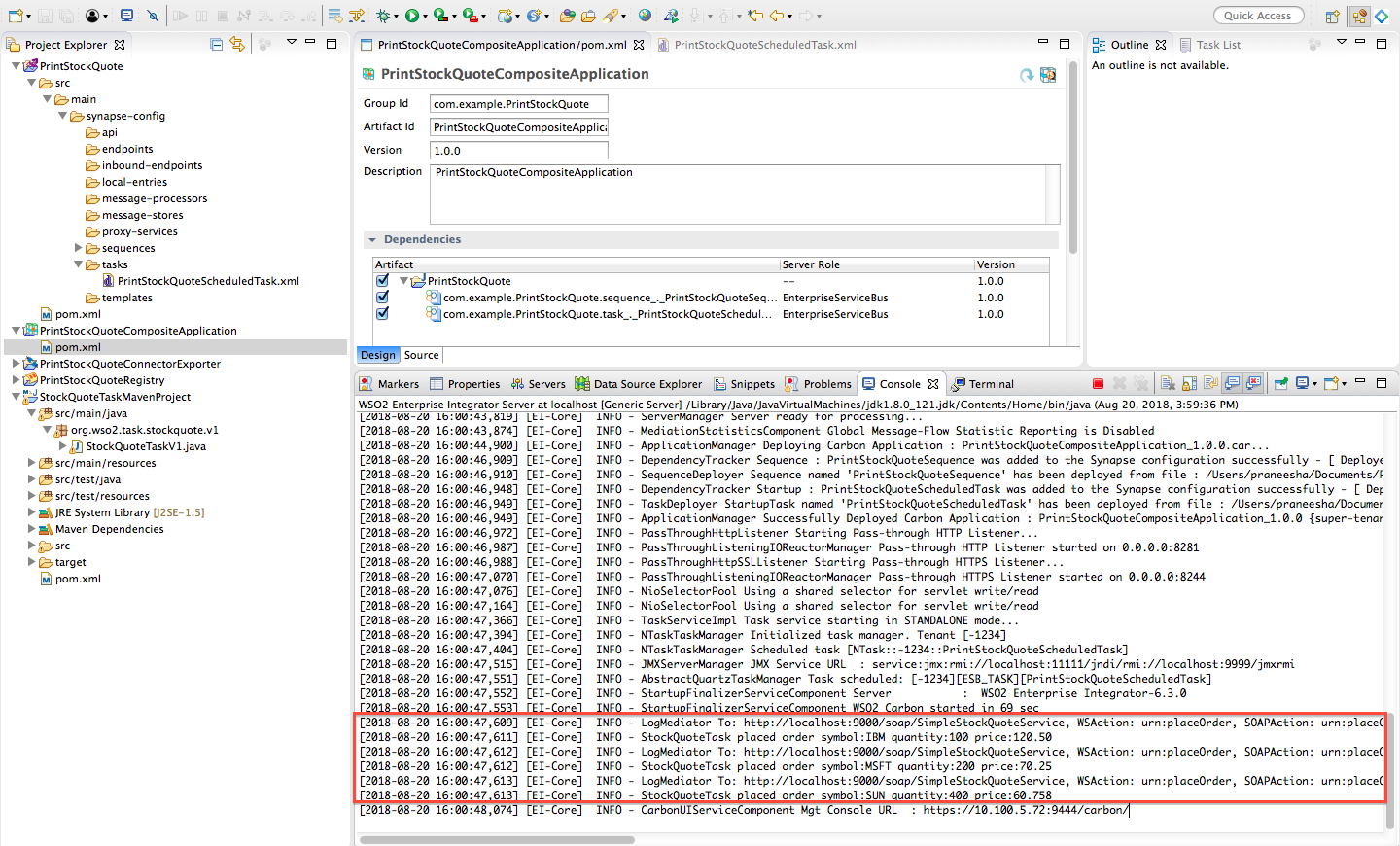Customizing Task Scheduling¶
When you create a task using the default task implementation, the task can inject messages to a proxy service, or to a sequence. If you have a specific task-handling requirement, you can write your own task-handling implementation by creating a custom Java Class that implements the org.apache.synapse.startup.Task interface.
For example, the below sections demonstrate how you can create and schedule a task to receive stock quotes by invoking a back-end service, which exposes stock quotes. The scheduled task will read stock order information from a text file, and print the stock quotes.
Creating the custom Task implementation¶
Follow the steps below to create the implementation of the custom Task.
Creating the Maven Project¶
Create a Maven Project using the following information.
Tip
You can skip step 5 since you do not need to add external JAR files in this example.
- Group Id : org.wso2.task
- Artifact Id : StockQuoteTaskMavenProject
Creating the Java Package¶
Create a Java Package inside the Maven Project using the following name: org.wso2.task.stockquote.v1

Creating the Java Class¶
-
Create a Java Class inside the Maven Project using the following name:
StockQuoteTaskV1 -
In the Project Explorer, double-click on the StockQuoteTaskV1.java file and replace its source with the below content.
package org.wso2.task.stockquote.v1; import java.io.BufferedReader; import java.io.File; import java.io.FileReader; import java.io.IOException; import org.apache.axiom.om.OMAbstractFactory; import org.apache.axiom.om.OMElement; import org.apache.axiom.om.OMFactory; import org.apache.axiom.om.OMNamespace; import org.apache.axis2.addressing.EndpointReference; import org.apache.commons.logging.Log; import org.apache.commons.logging.LogFactory; import org.apache.synapse.ManagedLifecycle; import org.apache.synapse.MessageContext; import org.apache.synapse.SynapseException; import org.apache.synapse.core.SynapseEnvironment; import org.apache.synapse.startup.Task; import org.apache.synapse.util.PayloadHelper; public class StockQuoteTaskV1 implements Task, ManagedLifecycle { private Log log = LogFactory.getLog(StockQuoteTaskV1.class); private String to; private String stockFile; private SynapseEnvironment synapseEnvironment; public void execute() { log.debug("PlaceStockOrderTask begin"); if (synapseEnvironment == null) { log.error("Synapse Environment not set"); return; } if (to == null) { log.error("to not set"); return; } File existFile = new File(stockFile); if (!existFile.exists()) { log.debug("waiting for stock file"); return; } try { // file format IBM,100,120.50 BufferedReader reader = new BufferedReader(new FileReader(stockFile)); String line = null; while ((line = reader.readLine()) != null) { line = line.trim(); if (line == "") { continue; } String[] split = line.split(","); String symbol = split[0]; String quantity = split[1]; String price = split[2]; MessageContext mc = synapseEnvironment.createMessageContext(); mc.setTo(new EndpointReference(to)); mc.setSoapAction("urn:placeOrder"); mc.setProperty("OUT_ONLY", "true"); OMElement placeOrderRequest = createPlaceOrderRequest(symbol, quantity, price); PayloadHelper.setXMLPayload(mc, placeOrderRequest); synapseEnvironment.injectMessage(mc); log.info("placed order symbol:" + symbol + " quantity:" + quantity + " price:" + price); } reader.close(); } catch (IOException e) { throw new SynapseException("error reading file", e); } File renamefile = new File(stockFile); renamefile.renameTo(new File(stockFile + "." + System.currentTimeMillis())); log.debug("PlaceStockOrderTask end"); } public static OMElement createPlaceOrderRequest(String symbol, String qty, String purchPrice) { OMFactory factory = OMAbstractFactory.getOMFactory(); OMNamespace ns = factory.createOMNamespace("http://services.samples/xsd", "m0"); OMElement placeOrder = factory.createOMElement("placeOrder", ns); OMElement order = factory.createOMElement("order", ns); OMElement price = factory.createOMElement("price", ns); OMElement quantity = factory.createOMElement("quantity", ns); OMElement symb = factory.createOMElement("symbol", ns); price.setText(purchPrice); quantity.setText(qty); symb.setText(symbol); order.addChild(price); order.addChild(quantity); order.addChild(symb); placeOrder.addChild(order); return placeOrder; } public void destroy() {} public void init(SynapseEnvironment synapseEnvironment) { this.synapseEnvironment = synapseEnvironment; } public SynapseEnvironment getSynapseEnvironment() { return synapseEnvironment; } public void setSynapseEnvironment(SynapseEnvironment synapseEnvironment) { this.synapseEnvironment = synapseEnvironment; } public String getTo() { return to; } public void setTo(String to) { this.to = to; } public String getStockFile() { return stockFile; } public void setStockFile(String stockFile) { this.stockFile = stockFile; } }
-
In the Project Explorer, double-click on the pom.xml file and replace its source with the below content.
<project xmlns="http://maven.apache.org/POM/4.0.0" xmlns:xsi="http://www.w3.org/2001/XMLSchema-instance" xsi:schemaLocation="http://maven.apache.org/POM/4.0.0 http://maven.apache.org/xsd/maven-4.0.0.xsd"> <modelVersion>4.0.0</modelVersion> <groupId>org.wso2.task</groupId> <artifactId>StockQuoteTask</artifactId> <version>0.0.1-SNAPSHOT</version> <repositories> <repository> <id>wso2.releases</id> <name>WSO2 internal Repository</name> <url>http://maven.wso2.org/nexus/content/repositories/releases/</url> <releases> <enabled>true</enabled> <updatePolicy>daily</updatePolicy> <checksumPolicy>ignore</checksumPolicy> </releases> </repository> </repositories> <dependencies> <dependency> <groupId>org.apache.synapse</groupId> <artifactId>synapse-core</artifactId> <version>2.1.7-wso2v65</version> </dependency> </dependencies> </project>
Writing the custom Task¶
Step 1: Writing the Task Class¶
You can create a custom task class, which implements the
org.apache.synapse.startup.Task interface
as follows. This interface has a single
execute() method, which contains the code
that will be executed according to the defined schedule.
The execute() method contains the
following actions:
- Check whether the file exists at the desired location.
- If it does, then read the file line by line composing place order messages for each line in the text file.
- Individual messages are then injected to the synapse environment with the given
Toendpoint reference. - Set each message as
OUT_ONLYsince it is not expected any response for messages.
In addition to the execute() method, it
is also possible to make the class implement a
JavaBean interface.
Also, add the following dependency to the POM file of the custom task project: MWARE Carbon - Utilities bundle (symbolic name: org.wso2.carbon.utils )
This is a bean implementing two properties: To and StockFile. These are used to configure the task.
Implementing ManagedLifecycle for Initialization and Clean-up
Since a task implements ManagedLifecyle
interface, the Micro Integrator will call the
init() method at the initialization of a
Task object and
destroy() method when a
Task object is destroyed:
public interface ManagedLifecycle {
public void init(SynapseEnvironment se);
public void destroy();
}The PlaceStockOrderTask stores the
Synapse environment object reference in an instance variable for
later use with the init() method. The
SynapseEnvironment is needed for
injecting messages into the ESB.
Step 2: Customizing the Task¶
It is possible to pass values to a task at runtime using property
elements. In this example, the location of the stock order file and
its address was given using two properties within the
Task object:
- String type
- OMElement type
Info
For OMElement type, it is possible to pass XML elements as values in the configuration file.
When creating a Task object, the ESB will
initialize the properties with the given values in the configuration
file.
public String getStockFile() {
return stockFile;
}
public void setStockFile(String stockFile) {
this.stockFile = stockFile;
}For example, the following properties in the
Task class are initialized with the given
values within the property element of the task in the configuration.
<syn:property xmlns="http://ws.apache.org/ns/synapse" name="stockFile"value="/home/upul/test/stock.txt"/>For those properties given as XML elements, properties need to be defined within the Task class using the format given below. OMElement comes from Apache AXIOM, which is used by the Micro Integrator. AXIOM is an object model similar to DOM. To learn more about AXIOM, see the tutorial in the AXIOM user guide .
public void setMessage(OMElement elem) {
message = elem;}It can be initialized with an XML element as follows:
<property name="message">
<m0:getQuote xmlns:m0="http://services.samples/xsd">
<m0:request>
<m0:symbol>IBM</m0:symbol>
</m0:request>
</m0:getQuote>
</property>Deploying the custom Task implementation¶
Deploy the custom Task implementation.
Creating the Task¶
Follow the steps below to create the task and schedule it.
- Create a ESB Config project named
PrintStockQuote. - Create a Sequence using the following information named
PrintStockQuoteSequence. -
Add a Log Mediator and a Drop Mediator to the sequence and configure them.

The below is the complete source configuration of the Sequence (i.e., the
PrintStockQuoteSequence.xmlfile):<?xml version="1.0" encoding="UTF-8"?> <sequence name="PrintStockQuoteSequence" trace="disable" xmlns="http://ws.apache.org/ns/synapse"> <log level="custom"/> <drop/> </sequence> -
Create a Scheduled Task using the following information:
Task Property Description Task Name PrintStockQuoteScheduledTaskCount 1 Interval (in seconds) 5 
-
Defining the properties of the Task: In the Project Explorer , double-click the Print StockQuoteScheduledTask.xml file and replace its source with the below content.
The task properties will change according to the custom implementation. Therefore, you need to enter values for your custom properties. This sets the below properties.<task class="org.apache.synapse.startup.tasks.MessageInjector" group="synapse.simple.quartz" name="PrintStockQuoteScheduledTask" xmlns="http://ws.apache.org/ns/synapse"> <trigger count="1" interval="5" /> <property name="to" value="http://localhost:9000/soap/SimpleStockQuoteService" xmlns:task="http://www.wso2.org/products/wso2commons/tasks" /> <property name="stockFile" value="/Users/praneesha/Desktop/stockfile.txt" xmlns:task="http://www.wso2.org/products/wso2commons/tasks" /> <property name="synapseEnvironment" value="" xmlns:task="http://www.wso2.org/products/wso2commons/tasks" /> </task>Parameter Name Value to http://localhost:9000/soap/SimpleStockQuoteService stockFileThe directory path to the stockfile.txtfile.synapseEnvironmentDo not enter a value. This will be used during runtime. Note
Currently, you cannot set properties of a custom task using the Design View due to a known issue, which will be fixed in future versions.
The below is the complete source configuration of the Task (i.e., the PrintStockQuoteScheduledTask.xml file).
<?xml version="1.0" encoding="UTF-8"?>
<task class="org.apache.synapse.startup.tasks.MessageInjector" group="synapse.simple.quartz" name="PrintStockQuoteScheduledTask" xmlns="http://ws.apache.org/ns/synapse">
<trigger interval="3" />
<property name="to" value="http://localhost:9000/soap/SimpleStockQuoteService" xmlns:task="http://www.wso2.org/products/wso2commons/tasks" />
<property name="stockFile" value="/Users/praneesha/Desktop/stockfile.txt" xmlns:task="http://www.wso2.org/products/wso2commons/tasks" />
</task>Deploying the Task¶
Deploy the Task.
Testing the Custom Task¶
Starting the back-end service¶
Download the backend service from GitHub and run it.
Creating the text file¶
Create a text file named stockfile.txt with the following content and save it to a preferred location on your
machine. This will include the information to be read by the scheduled task to pass to the backend service.
stockfile.txt
IBM,100,120.50
MSFT,200,70.25
SUN,400,60.758Info
Each line in the text file contains details for a stock order:
- symbol
- quantity
- price
A task that is scheduled using this custom implementation will read the text file, a line at a time, and create orders using the given values to be sent to the back-end service. The text file will then be tagged as processed to include a system time stamp. The task will be scheduled to run every 15 seconds.
Viewing the output¶
You will view the stock quotes sent by the backend service printed every 3 seconds by the scheduled task in the below format.
INFO - StockQuoteTask placed order symbol:IBM quantity:100 price:120.50